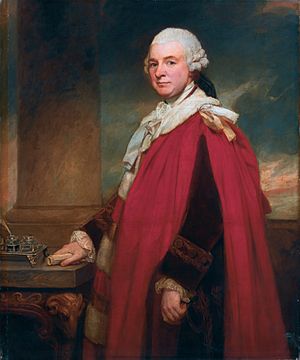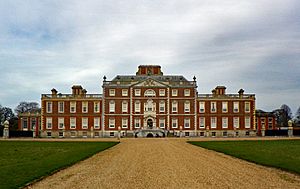Philip Yorke, 2nd Earl of Hardwicke facts for kids
Quick facts for kids
The Earl of Hardwicke
|
|
|---|---|

Lord Hardwicke in the parliamentary robes of an earl, by George Romney c. 1776
|
|
| Born |
Philip Yorke
9 March 1720 |
| Died | 16 May 1790 |
| Alma mater | Corpus Christi College, Cambridge |
| Spouse(s) |
Lady Jemima Campbell
(m. 1740) |
Philip Yorke, 2nd Earl of Hardwicke (born March 9, 1720 – died May 16, 1790), was an important English politician and writer. He was also known as Viscount Royston for a time. He followed in his famous father's footsteps, becoming a key figure in British politics during the 1700s. He was also a Fellow of the Royal Society, a group for top scientists and thinkers.
Contents
Life of Philip Yorke
Early Life and Education
Philip Yorke was the oldest son of Philip Yorke, 1st Earl of Hardwicke. He went to Newcome's School and later to Corpus Christi College, Cambridge. In 1738, he was given a job called Teller of the Exchequer, which he held for his entire life. This role involved managing government money. In 1741, he became a Fellow of the Royal Society, which is a special honor for people who have made important discoveries or contributions to science.
Political Career and Public Service
Philip Yorke was a member of the House of Commons, which is part of the British Parliament. He represented Reigate from 1741 to 1747, and then Cambridgeshire. He took notes during important debates, and these notes were later used in a book called Parliamentary History.
When there was a political problem in 1756 about losing a place called Minorca to the French, Philip Yorke helped the government. He worked with his father and another important person, Lord Mansfield, to defend the government during official investigations.
From 1754 to 1764, he was known by the special title of Viscount Royston. In 1764, when his father passed away, Philip became the 2nd Earl of Hardwicke. He also inherited the large Wimpole estate in Cambridgeshire. When King George III became king in 1760, Philip Yorke was sworn into the Privy Council. This meant he became a trusted advisor to the King.
In politics, he supported a group called the Whigs, specifically those led by Lord Rockingham. He also held important local roles, like Lord Lieutenant of Cambridgeshire from 1757 until his death. He was also a high steward of Cambridge University. He collected and edited many important government papers and letters, which are now kept in the British Museum. From 1756 to 1760, he was a vice president of the Foundling Hospital, a charity that cared for children who had been abandoned in London.
He passed away in 1790 and was buried in Flitton, Bedfordshire. A special monument was made for him by the sculptor Thomas Banks.
Written Works
Philip Yorke worked with his brother, Charles Yorke, on a famous book called Athenian Letters; or the Epistolary Correspondence of an agent of the King of Persia residing at Athens during the Peloponnesian War. This book was published in four parts starting in 1741. It was written as if it were letters from a Persian agent living in ancient Athens during a big war. The book was very popular for many years and was printed many times.
Family Life and Children
On May 22, 1740, Philip Yorke married Lady Jemima Campbell. She was the only daughter of John Campbell, 3rd Earl of Breadalbane. When her grandfather, the Duke of Kent, died in 1740, Jemima inherited his titles. This meant she became the 2nd Marchioness Grey and 4th Baroness Lucas in her own right, which means she held these titles herself, not through her husband.
Philip and Jemima had two daughters:
- Lady Amabel Yorke, 1st Countess de Grey (born January 23, 1751 – died March 4, 1833). She was their older daughter and married Alexander Hume-Campbell, Lord Polwarth. They did not have any children. She later became the 5th Baroness Lucas after her mother.
- Lady Mary Jemima Yorke (born February 9, 1756 – died 1830). She married Thomas Robinson, 2nd Baron Grantham and they had children.
Succession
After Philip Yorke, the 2nd Earl of Hardwicke, passed away, his nephew Philip Yorke, 3rd Earl of Hardwicke became the next Earl.



